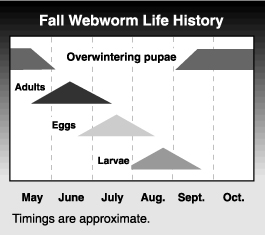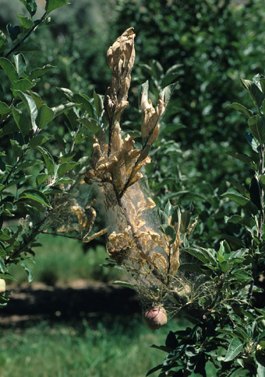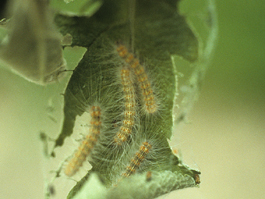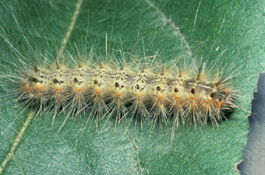by Jay F. Brunner and Rich Zack, originally published 1993
Hyphantria cunea Drury (Lepidoptera: Arctiidae)
The fall webworm is native to North America and is found throughout the United States, Canada and Mexico. It inflicts the most damage on shade trees, but can cause problems in apple and pear orchards. Its larvae spin large webs in the trees, which may enclose entire branches. The larvae are primarily leaf feeders, but if fruit is enclosed in the webs they will feed on it. These webs are formed in August, whereas those of the tent caterpillar appear in the spring.
Hosts
The fall webworm feeds on almost all fruit, forest and shade trees, except conifers.
Life stages
Egg
The egg is round, about 1/50 inch (0.5 mm) in diameter. It is pale green or yellow. Eggs are laid in masses on both sides of leaves and are partly covered with white hairs from the female’s body.
Larva
The mature caterpillar is yellowish or tawny, with a dark stripe down the back and rows of distinctive black and orange-yellow tubercles on each side. The body is covered by long, fine, light colored hairs. When fully grown it is about 1 inch (25 mm) long.
Pupa
The reddish brown pupa is about 1/2 inch (12 mm) long.
Adult
The adult moth is satiny white, with long, soft hair, and may have brown or black spots on the wings. It measures 1 to 1-1/4 inches (25 to 30 mm) across with the wings expanded.
Life history
 The fall webworm has one generation in the Pacific Northwest. It overwinters as a pupa in a cocoon under debris on the ground, in bark crevices, or in the soil. Adults emerge in summer and females deposit eggs on leaves in masses of 300 to 400. Eggs hatch in about 10 days. The young larvae live as a colony within balloon-like webs, which contain leaves on which they feed. The webs expand as the larvae grow and can measure up to 2 feet long. When almost full grown, caterpillars often feed outside the web at night. As food becomes scarce on a branch, caterpillars may migrate to another branch or tree. Larvae mature and pupate in the fall.
The fall webworm has one generation in the Pacific Northwest. It overwinters as a pupa in a cocoon under debris on the ground, in bark crevices, or in the soil. Adults emerge in summer and females deposit eggs on leaves in masses of 300 to 400. Eggs hatch in about 10 days. The young larvae live as a colony within balloon-like webs, which contain leaves on which they feed. The webs expand as the larvae grow and can measure up to 2 feet long. When almost full grown, caterpillars often feed outside the web at night. As food becomes scarce on a branch, caterpillars may migrate to another branch or tree. Larvae mature and pupate in the fall.
Damage
The larvae eat foliage and fruit within their webs. They can strip all the foliage off small trees but usually attack only certain limbs or parts of limbs on larger trees. Larvae make broad, shallow feeding tracts on the fruit surface. Fruit on defoliated limbs may be stunted and shriveled.
Monitoring

Because of the webs, fall webworms are conspicuous even in small numbers.
Biological control
The fall webworm has many natural enemies including the braconid wasps Meteorus hyphantria and Apanteles hyphantria.
Management
Prune small webs out of the tree when they appear, remove them from the orchard, and dispose of by burning when conditions are appropriate for safe burning or by freezing. Webs can also be spot treated with a hand gun or backpack sprayer. Fall webworm is susceptible to insecticides used for other fruit pests and is primarily a problem in young or unsprayed orchards. However, with increased use of mating disruption and other soft pesticide programs, this insect may become more common in commercial orchards.


